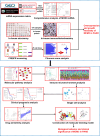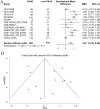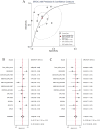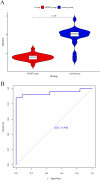Expression, potential biological behaviour and clinical significance of MCM3 in pancreatic adenocarcinoma: a comprehensive study integrating high throughput sequencing, CRISPR screening and in-house immunohistochemistry
- PMID: 39310930
- PMCID: PMC11421141
- DOI: 10.1080/07853890.2024.2405879
Expression, potential biological behaviour and clinical significance of MCM3 in pancreatic adenocarcinoma: a comprehensive study integrating high throughput sequencing, CRISPR screening and in-house immunohistochemistry
Abstract
Background: Minichromosome maintenance complex component 3 (MCM3) plays a key role in various tumours. However, it remains largely unknown what the specific role and clinical significance of MCM3 in pancreatic adenocarcinoma (PAAD) are.
Materials and methods: We integrated high-throughput data from PAAD worldwide to analyse the expression level of MCM3 mRNA. We used immunohistochemistry to analyse MCM3 protein expression levels in 145 cases in the PAAD group and 29 cases in the non-PAAD group. We also mainly analysed the necessity of MCM3 for PAAD growth based on CRISPR screen data. In addition, we used enrichment analysis and protein-protein interaction networks to explore the molecular mechanism of MCM3 in PAAD. We also analysed the correlation between MCM3 expression, components of the immune microenvironment in PAAD tissue and clinical prognosis.
Results: In PAAD, we observed for the first time that MCM3 was significantly highly expressed at both the mRNA (SMD = 0.67, 95% CI: 0.38 ∼ 0.96) and the protein level (p < 0.05). The mRNA (AUC = 0.78, 95% CI: 0.74 ∼ 0.81; sensitivity = 0.66, 95% CI: 0.55 ∼ 0.76; specificity = 0.76, 95% CI: 0.67 ∼ 0.84) and protein (AUC = 0.929) expression levels of MCM3 had a good ability to distinguish between PAAD and non-PAAD tissue. There was heterogeneity reflected by the differential expression of MCM3 protein in PAAD cells. MCM3 played an essential role in PAAD growth, through abnormal DNA replication, p53 signalling and cell cycle checkpoints. PAAD with high MCM3 expression was sensitive to c-75, brivanib, flavopiridol and VNLG/124 drugs, with stable molecular docking models.
Conclusion: MCM3 is likely to be a critical element in promoting the initiation and growth of PAAD. Flavopiridol may exert its anti-PAAD effect through the interaction between MCM3, classic CDK1 targets in the cell cycle checkpoint and p53 pathway as well as related molecules in other pathways.
Keywords: CRISPR screening; MCM3; high-throughput sequencing; immunohistochemistry; pancreatic adenocarcinoma.
Plain language summary
MCM3 could potentially play a crucial role in promoting the onset and growth of PAAD.There is heterogeneity reflected by the differential expression of MCM3 protein in PAAD cells.The interplay between MCM3, well-established CDK1 targets in the cell cycle checkpoint and p53 pathway, along with relevant molecules in other pathways, may mediate the anti-pancreatic adenocarcinoma (PAAD) effect of flavopiridol.
Conflict of interest statement
No potential conflict of interest was reported by the authors.
Figures










Similar articles
-
Identification of a novel prognostic marker ADGRG6 in pancreatic adenocarcinoma: multi-omics analysis and experimental validation.Front Immunol. 2025 Mar 27;16:1530789. doi: 10.3389/fimmu.2025.1530789. eCollection 2025. Front Immunol. 2025. PMID: 40226617 Free PMC article.
-
A novel immune checkpoint score system for prognostic evaluation in pancreatic adenocarcinoma.BMC Gastroenterol. 2023 Apr 6;23(1):113. doi: 10.1186/s12876-023-02748-w. BMC Gastroenterol. 2023. PMID: 37024802 Free PMC article.
-
Multiple Perspectives Reveal the Role of DNA Damage Repair Genes in the Molecular Classification and Prognosis of Pancreatic Adenocarcinoma.Int J Mol Sci. 2022 Sep 6;23(18):10231. doi: 10.3390/ijms231810231. Int J Mol Sci. 2022. PMID: 36142142 Free PMC article.
-
ZP3 Expression in Pancreatic Adenocarcinoma: Its Implications for the Prognosis and Therapy.Protein Pept Lett. 2025;32(2):124-138. doi: 10.2174/0109298665350171241204153202. Protein Pept Lett. 2025. PMID: 39791146
-
Identify potential prognostic indicators and tumor-infiltrating immune cells in pancreatic adenocarcinoma.Biosci Rep. 2022 Feb 25;42(2):BSR20212523. doi: 10.1042/BSR20212523. Biosci Rep. 2022. PMID: 35083488 Free PMC article. Review.
Cited by
-
Overexpression of LINC00880 promotes colorectal cancer growth.Transl Cancer Res. 2025 May 30;14(5):2926-2939. doi: 10.21037/tcr-2025-54. Epub 2025 May 23. Transl Cancer Res. 2025. PMID: 40530165 Free PMC article.
References
MeSH terms
Substances
LinkOut - more resources
Full Text Sources
Other Literature Sources
Medical
Research Materials
Miscellaneous
